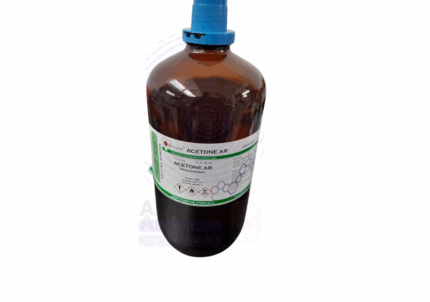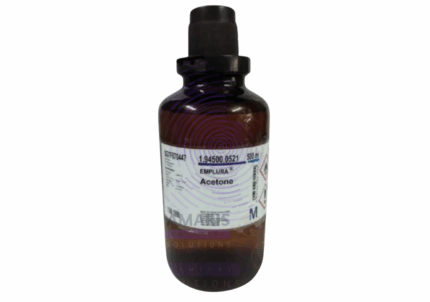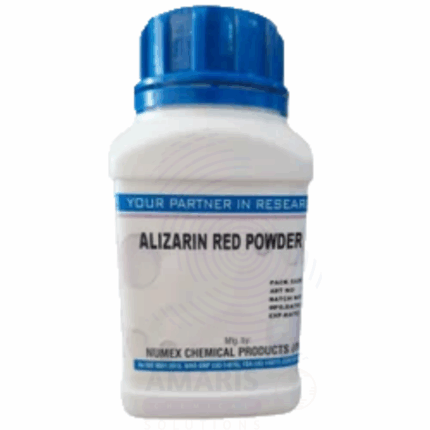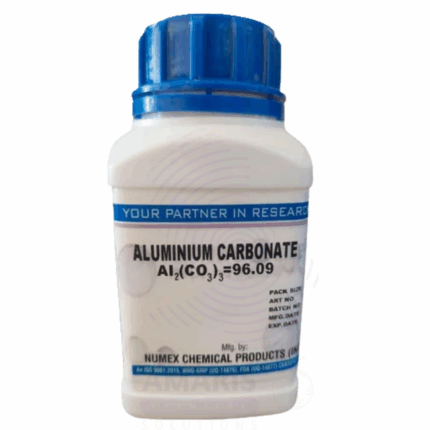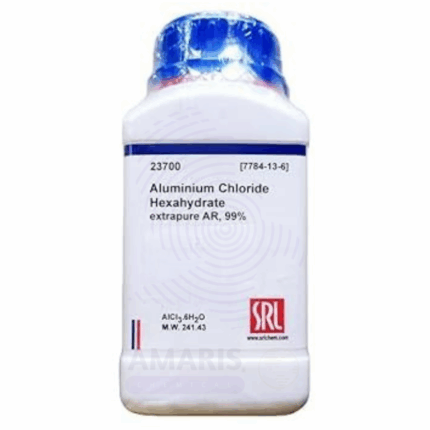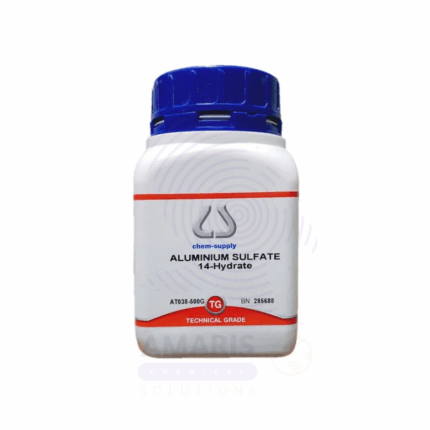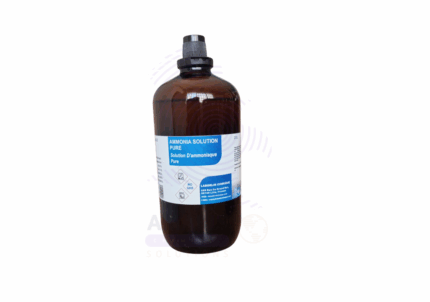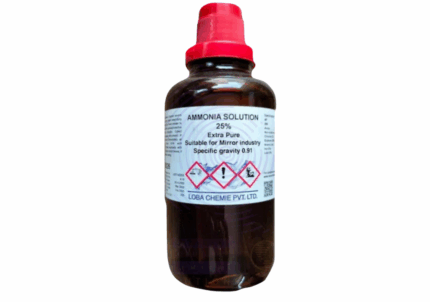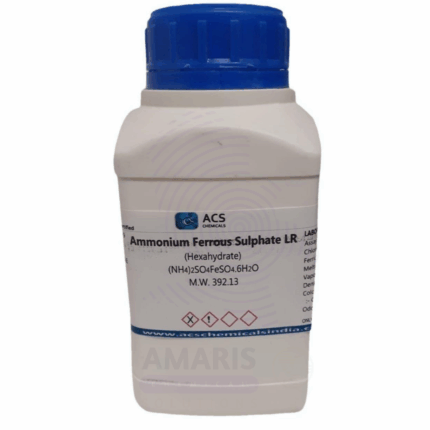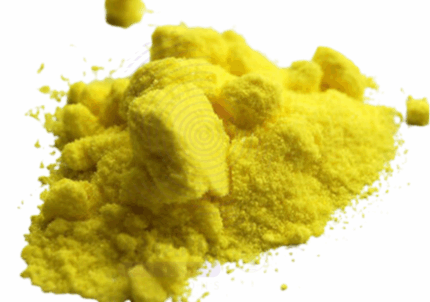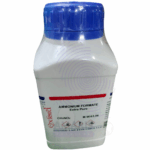
Ammonium Hydrogen Carbonate Extra Pure
$ 18.00 Original price was: $ 18.00.$ 17.54Current price is: $ 17.54.
Ammonium Hydrogen Carbonate Extra Pure, also known as ammonium bicarbonate, is a high-purity, white crystalline powder widely used in laboratory settings as a buffering agent, leavening agent, and source of ammonia and carbon dioxide in thermal decomposition studies. It is particularly useful in analytical chemistry for preparing buffer solutions and in gas evolution experiments due to its ability to decompose readily upon heating. In protein and enzyme work, it serves as a volatile buffer compatible with mass spectrometry. The extra pure grade ensures minimal contamination, supporting accurate and reproducible results in sensitive applications. It should be stored in tightly sealed containers in a cool, dry environment to prevent premature decomposition and loss of efficacy.
Ammonium Hydrogen Carbonate Extra Pure
Primary Use
- Volatile Buffer in Mass Spectrometry & Proteomics
- Used to buffer enzymatic digestions (e.g., trypsin) in proteomics; volatile nature allows easy removal by lyophilization before MS analysis.
- Reagent in Inorganic and Analytical Chemistry
- Supplies carbonate and ammonium ions for precipitation, pH control, or decomposition studies in teaching and research labs.
- Source of CO₂ and NH₃ for Gas Evolution Studies
- Decomposes upon heating or in acidic conditions—used in demonstrations of gas evolution, decomposition, and equilibrium.
- Component in Buffer Systems for Biochemistry
- Acts as a mild, temporary buffer in protein work, maintaining near-neutral pH during sample preparation.
- Teaching Acid–Base and Salt Behavior
- Ideal for student labs to explore decomposition, thermal instability, and the behavior of weak acid–weak base salts.
Secondary Uses
- Precursor in Synthesis of Ammonium or Carbonate Salts
- Used to prepare other salts such as ammonium carbonate, ammonium formate, or sodium bicarbonate derivatives in situ.
- pH Adjustment in Experimental Protocols
- Provides gentle alkalinity in sensitive biochemical reactions or where strong bases may be disruptive.
- Simulation of Metabolic or Environmental Reactions
- Models decomposition of organic nitrogen in soil, waste, or fermentation chemistry experiments.
- Nutrient in Microbial Growth Media (Experimental Use)
- Occasionally studied as a nitrogen and carbon source in microbial cultures or synthetic biology.
- Thermal Decomposition Kinetics Studies
- Investigated in TGA (Thermogravimetric Analysis) and DSC for its clean breakdown into gases.
| PACK SIZE |
500 grams Plastic Tin |
|---|
1. Basic Identification Attributes
- Chemical Name: Ammonium Hydrogen Carbonate
- CAS Number: 1066-33-7
- HS Code: 28369990 (Other carbonates, including hydrogen carbonates)
- Molecular Formula: NH₄HCO₃
- Synonyms:
- Ammonium bicarbonate
- Acid ammonium carbonate
- Baking ammonia (in food-grade context)
- Ammonium acid carbonate
2. Physical & Chemical Properties
- Physical State: Solid (crystalline powder)
- Color & Odor: White; slight ammonia odor
- Boiling Point: Decomposes before boiling
- Melting Point: Decomposes at ~36–60°C
- Density/Specific Gravity: ~1.59 g/cm³
- Solubility:
- Water: Soluble (~17 g/100 mL at 20°C)
- Alcohol: Insoluble
- pH Level: ~7.7–8.5 (in 1% aqueous solution; mildly alkaline)
- Vapor Pressure: Low (but decomposes to form NH₃ and CO₂ gases)
- Flash Point: Not flammable
- Autoignition Temperature: Not applicable
- Viscosity: Not applicable
3. Safety & Hazard Attributes
- Hazard Class (GHS):
- Eye Irritation (Category 2A)
- Skin Irritation (Category 2)
- Acute Toxicity – Oral (Category 4)
- NFPA Ratings:
- Health: 1
- Flammability: 0
- Reactivity: 1
- Exposure Limits:
- No established OSHA or ACGIH limits for this compound
- General dust handling precautions apply
- Reactivity:
- Decomposes to ammonia, carbon dioxide, and water upon heating
- Reacts with acids to release CO₂
- Incompatible with strong acids and bases
4. Storage & Handling Attributes
- Storage Conditions:
- Store in a cool, dry, well-ventilated area
- Keep container tightly closed and away from heat/moisture
- Incompatible Materials:
- Acids, strong oxidizers, strong bases
- Container Type:
- Airtight plastic or glass containers
- Shelf Life & Expiration Date:
- ~1 year; decomposes gradually if exposed to air
- Special Handling Requirements:
- Use in a fume hood if handling large quantities
- Wear gloves and goggles; avoid inhaling dust or fumes
5. Regulatory & Compliance Attributes
- Regulatory Status:
- Listed under TSCA, REACH
- Also permitted in food-grade and pharmaceutical applications (different grade)
- Transportation Restrictions:
- Not classified as a hazardous material
- Waste Disposal Method:
- Dilute and allow to decompose under controlled conditions
- Dispose in accordance with institutional chemical waste policy
6. Environmental & Health Impact
- Ecotoxicity:
- Low; decomposes to naturally occurring components
- Persistence in Environment:
- Not persistent; rapidly decomposes
- Carcinogenicity/Mutagenicity:
- Not classified as carcinogenic or mutagenic
- Biodegradability:
- Inorganic, but readily breaks down into biodegradable products
SAFETY PRECAUTIONS
- Personal Protective Equipment (PPE):
- Wear a lab coat, safety goggles, and chemical-resistant gloves (e.g., nitrile).
- Use in a well-ventilated area or under a fume hood to prevent buildup of vapors.
- Handling:
- Avoid breathing dust or vapors—it decomposes to form ammonia, carbon dioxide, and water.
- Handle with care to minimize dust formation.
- Avoid contact with skin and eyes.
- Keep away from acids, heat, and moisture.
- Storage:
- Store in a tightly closed container in a cool, dry, and well-ventilated place.
- Keep away from sources of heat and acidic substances.
- Protect from moisture to prevent decomposition and gas release.
- Hygiene Measures:
- Wash hands thoroughly after handling.
- Do not eat, drink, or smoke in the lab.
- Clean work surfaces after use to prevent residue exposure.
FIRST AID MEASURES
- Inhalation:
- Move person to fresh air immediately.
- If breathing is difficult, provide oxygen and seek medical attention.
- Ammonia fumes can irritate the respiratory system.
- Skin Contact:
- Remove contaminated clothing.
- Wash exposed skin thoroughly with soap and water.
- Seek medical attention if irritation or discomfort develops.
- Eye Contact:
- Flush eyes with clean water for at least 15 minutes.
- Hold eyelids apart to ensure thorough rinsing.
- Seek medical attention if irritation or vision changes occur.
- Ingestion:
- Rinse mouth with water.
- Do not induce vomiting.
- If the person is conscious, give water to dilute.
- Seek immediate medical attention—may irritate the gastrointestinal tract.
FIRE FIGHTING MEASURES
- Suitable Extinguishing Media:
- Use dry chemicals, carbon dioxide (CO₂), foam, or water spray depending on nearby materials.
- Specific Hazards:
- Non-flammable, but decomposes with heat to produce ammonia and carbon dioxide.
- Vapors can cause irritation and may contribute to confined-space pressure build-up.
- Protective Equipment for Firefighters:
- Use self-contained breathing apparatus (SCBA) and full protective gear.
- Firefighting Instructions:
- Cool containers with water spray to prevent pressure buildup.
- Avoid breathing decomposition gases.
- Prevent runoff from entering sewers or waterways—toxic to aquatic life in high concentrations.


 Preservatives(food)
Preservatives(food) Flavor Enhancers
Flavor Enhancers Acidulants
Acidulants Sweeteners
Sweeteners Antioxidants
Antioxidants Colorants(food)
Colorants(food) Nutraceutical Ingredients (food)
Nutraceutical Ingredients (food) Nutrient Supplements
Nutrient Supplements Emulsifiers
Emulsifiers
 Collectors
Collectors Dust Suppressants
Dust Suppressants Explosives and Blasting Agents
Explosives and Blasting Agents Flocculants and Coagulants
Flocculants and Coagulants Frothers
Frothers Leaching Agents
Leaching Agents pH Modifiers
pH Modifiers Precious Metal Extraction Agents
Precious Metal Extraction Agents
 Antioxidants(plastic)
Antioxidants(plastic) Colorants (Pigments, Dyes)
Colorants (Pigments, Dyes) Fillers and Reinforcements
Fillers and Reinforcements Flame Retardants
Flame Retardants Monomers
Monomers Plasticizers
Plasticizers Polymerization Initiators
Polymerization Initiators Stabilizers (UV, Heat)
Stabilizers (UV, Heat)
 Antifoaming Agents
Antifoaming Agents Chelating Agents
Chelating Agents Coagulants and Flocculants
Coagulants and Flocculants Corrosion Inhibitors
Corrosion Inhibitors Disinfectants and Biocides
Disinfectants and Biocides Oxidizing Agents
Oxidizing Agents pH Adjusters
pH Adjusters Scale Inhibitors( water)
Scale Inhibitors( water)
 Antioxidants(cosmetic)
Antioxidants(cosmetic) Emollients
Emollients Fragrances and Essential Oils
Fragrances and Essential Oils Humectants
Humectants Preservatives
Preservatives Surfactants(cosmetic)
Surfactants(cosmetic) Thickeners
Thickeners UV Filters
UV Filters
 Fertilizers
Fertilizers Soil Conditioners
Soil Conditioners Plant Growth Regulators
Plant Growth Regulators Animal Feed Additives
Animal Feed Additives Biostimulants
Biostimulants Pesticides (Herbicides, Insecticides, Fungicides)
Pesticides (Herbicides, Insecticides, Fungicides)
 Active Pharmaceutical Ingredients (APIs)
Active Pharmaceutical Ingredients (APIs) Excipients
Excipients Solvents(pharmaceutical)
Solvents(pharmaceutical) Antibiotics
Antibiotics Antiseptics and Disinfectants
Antiseptics and Disinfectants Vaccine Adjuvants
Vaccine Adjuvants Nutraceutical Ingredients (pharmaceutical)
Nutraceutical Ingredients (pharmaceutical) Analgesics & Antipyretics
Analgesics & Antipyretics
 Analytical Reagents
Analytical Reagents Solvents(lab)
Solvents(lab) Chromatography Chemicals
Chromatography Chemicals Spectroscopy Reagents
Spectroscopy Reagents microbiology-and-cell-culture-reagents
microbiology-and-cell-culture-reagents Molecular Biology Reagents
Molecular Biology Reagents Biochemical Reagents
Biochemical Reagents Inorganic and Organic Standards
Inorganic and Organic Standards Laboratory Safety Chemicals
Laboratory Safety Chemicals Specialty Laboratory Chemicals(Special Laboratory Equipment)
Specialty Laboratory Chemicals(Special Laboratory Equipment)
 Demulsifiers
Demulsifiers Hydraulic Fracturing Fluids
Hydraulic Fracturing Fluids Scale Inhibitors(oil)
Scale Inhibitors(oil) Surfactants(oil)
Surfactants(oil) Drilling Fluids
Drilling Fluids
 Dyes and Pigments
Dyes and Pigments Bleaching Agents
Bleaching Agents Softening Agents
Softening Agents Finishing Agents
Finishing Agents Antistatic Agents
Antistatic Agents
 Admixtures
Admixtures Waterproofing Agents
Waterproofing Agents Sealants and Adhesives
Sealants and Adhesives Curing Compounds
Curing Compounds Concrete Repair Chemicals
Concrete Repair Chemicals Anti-Corrosion Coatings
Anti-Corrosion Coatings
 Surfactants(cleaning)
Surfactants(cleaning) Builders
Builders Enzymes
Enzymes Solvents (Cleaning)
Solvents (Cleaning) Fragrances
Fragrances
 Electronic Chemicals
Electronic Chemicals Catalysts
Catalysts Lubricants
Lubricants Photographic Chemicals
Photographic Chemicals Refrigerants
Refrigerants Automotive chemicals
Automotive chemicals Pyrotechnic Chemicals
Pyrotechnic Chemicals
 Biodegradable Surfactants
Biodegradable Surfactants Bio-based Solvents
Bio-based Solvents Renewable Polymers
Renewable Polymers Carbon Capture Chemicals
Carbon Capture Chemicals Wastewater Treatment Chemicals
Wastewater Treatment Chemicals
 Pigments
Pigments Solvents(paint)
Solvents(paint) Specialty Coatings
Specialty Coatings Binders/Resins
Binders/Resins Additives
Additives Driers
Driers Anti-Corrosion Agents
Anti-Corrosion Agents Functional Coatings
Functional Coatings Application-Specific Coatings
Application-Specific Coatings
 Fresh Herbs
Fresh Herbs Ground Spices
Ground Spices Whole Spices
Whole Spices Spice Blends
Spice Blends Dried Herbs
Dried Herbs
 Leavening Agents
Leavening Agents Dough Conditioners
Dough Conditioners Flour Treatments
Flour Treatments Fat Replacers
Fat Replacers Decoratives
Decoratives Preservatives(baking)
Preservatives(baking)
 Plasticizers & Softeners
Plasticizers & Softeners Reinforcing Agents
Reinforcing Agents Adhesion Promoters
Adhesion Promoters Vulcanizing Agents
Vulcanizing Agents Antidegradants
Antidegradants Blowing Agents
Blowing Agents Fillers & Extenders
Fillers & Extenders Accelerators & Retarders
Accelerators & Retarders


